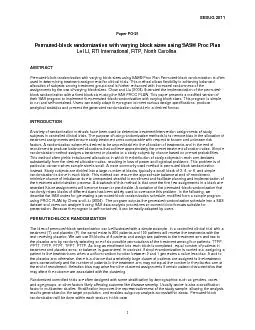PDF-block randomization with varying block sizes using SAS
Author : faustina-dinatale | Published Date : 2015-09-22
SESUG 2011 1 Paper PO 21 Permuted Lei Li RTI International RTP North Carolina ABSTRACT Permuted block randomization with varying block sizes using SAS
Presentation Embed Code
Download Presentation
Download Presentation The PPT/PDF document "block randomization with varying block s..." is the property of its rightful owner. Permission is granted to download and print the materials on this website for personal, non-commercial use only, and to display it on your personal computer provided you do not modify the materials and that you retain all copyright notices contained in the materials. By downloading content from our website, you accept the terms of this agreement.
block randomization with varying block sizes using SAS: Transcript
Download Rules Of Document
"block randomization with varying block sizes using SAS"The content belongs to its owner. You may download and print it for personal use, without modification, and keep all copyright notices. By downloading, you agree to these terms.
Related Documents














